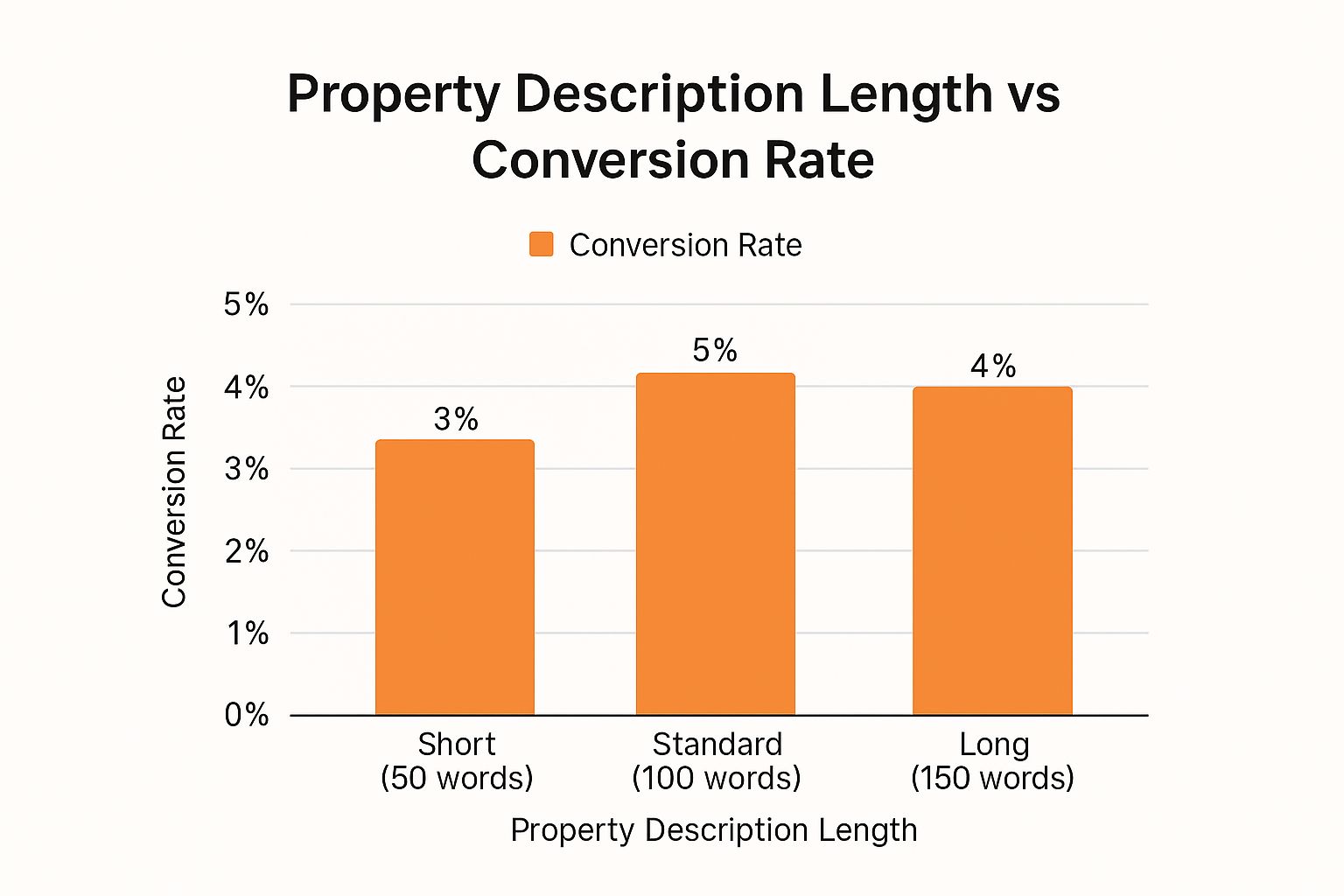Effective Copywriting for Real Estate to Sell Homes Fast
Discover expert copywriting for real estate that boosts property sales. Learn tips to craft compelling listings and attract Buyers today!
When you're writing about a property, you’re not just selling four walls and a roof. You’re selling a lifestyle, a feeling, a future. This is the secret to great copywriting for real estate. It’s about transforming a dry list of features into a compelling story that makes a potential buyer feel like they're already home.
Crafting a Narrative That Sells
Let's face it, most real estate listings are a total snooze-fest. They drone on about square footage, the number of bedrooms, and the brand of the dishwasher. But they miss the magic. Truly effective copy does the exact opposite—it weaves a narrative that sparks imagination and creates a sense of longing. This isn't about using slick, salesy language. It’s about getting inside the mind of a homebuyer and speaking to their dreams.
The most important shift you can make is to stop focusing on the property and start focusing on the person. Who is your dream buyer? A young professional looking for a sleek, low-maintenance condo? A growing family that needs a big backyard and a top-notch school district? Or maybe an investor who only cares about the numbers?
Know Who You're Talking To
To write copy that truly resonates, you have to know your audience. Taking a few minutes to sketch out a buyer persona will pay off in a big way.
- First-Time Homebuyers: These folks are often looking for affordability and convenience. They want a home that's move-in ready and close to friends and fun. Your writing should feel reassuring, highlighting how easy and enjoyable life will be in this home.
- Growing Families: For them, it's all about safety, community, and space. Think great schools, a fenced yard for the dog, and an open kitchen where everyone can gather. Your copy needs to paint that picture.
- Seasoned Investors: They're all business. Your description should get straight to the point: ROI, potential rental income, property appreciation, and low-maintenance perks.
When you tailor your words, you speak directly to what your ideal buyer cares about most. This principle of audience-focused writing is universal. To really dig in and improve your skills, you might want to check out a guide on how to master small business copywriting.
Before we go deeper, it's helpful to have a quick reference for what makes real estate copy work. The table below breaks down the essential components.
Core Elements of Effective Real Estate Copy
| Component | Objective | Example Tactic |
|---|---|---|
| Hooking Headline | Grab immediate attention and create curiosity. | Use a compelling question or highlight the most unique feature. |
| Opening Statement | Set the scene and establish an emotional tone. | Describe a specific experience, like "Sip your morning coffee on the sun-drenched deck." |
| Storytelling | Help buyers visualize themselves living in the home. | Connect features to benefits: "The open-concept kitchen is perfect for hosting." |
| Detailed Features | Provide essential, factual information clearly. | Use bullet points for easy scanning of specs, upgrades, and dimensions. |
| Call to Action (CTA) | Tell the reader exactly what to do next. | Be direct and create urgency: "Schedule your private tour today before it's gone!" |
Thinking about these elements helps you build a solid foundation for every property description you write.
Why Your Digital Copy Matters More Than Ever
The craft of copywriting isn't just a niche skill anymore; it's a massive global industry. Projections show the copywriting market will hit USD 42.83 billion by 2030, a boom fueled almost entirely by our shift to digital.
In real estate, this trend is impossible to ignore. With more than 54% of marketing budgets now dedicated to digital channels, your online listings, social media ads, and website copy are your primary tools for attracting buyers. You can explore more data on this growing market and its real estate implications over at Mordor Intelligence.
The best real estate copy doesn’t just describe a house; it sells a future. It answers the buyer's unspoken question: "Can I picture my best life here?"
By focusing on storytelling, knowing your buyer inside and out, and writing for a digital-first world, you create more than just a listing. You create a dream that turns casual browsers into motivated buyers ready to make an offer.
How to Write Property Descriptions That Sell

Let’s be honest. Nobody gets excited about a dry, technical list of room dimensions and appliance models. Your property description is a sales pitch, and its real job is to spark an emotional connection. The goal isn't just to inform; it's to make a potential buyer feel like they're already home.
You're crafting a story, one that helps buyers see their own lives unfolding within those walls. This means going way beyond simple features and translating them into genuine benefits and lived experiences.
Start with an Irresistible Opening
You have maybe three seconds to grab someone's attention online. That first sentence is your hook, and it has to be sharp enough to stop the scroll. Ditch the generic openers like "Beautiful 3-bedroom home." Instead, lead with the single most captivating thing about the property.
Think about the difference here:
Before: "Spacious 4-bed, 3-bath home in a great neighborhood. Features include a large kitchen and backyard."
After: "Imagine hosting summer barbecues in your expansive, private backyard, just steps from a gourmet kitchen practically designed for entertaining."
See what happened? The "After" version immediately drops the buyer right into the scene. It turns a boring list of features into a lifestyle they can actually picture themselves living. This shift from telling to showing is everything.
The most powerful descriptions don't just list what a house has; they illustrate what a new owner gets to do there. It’s the difference between "a deck" and "a deck perfect for morning coffee while watching the sunrise."
Weave in Sensory and Emotional Language
The best descriptions make you feel something. They appeal directly to the senses. Use words that help buyers see, feel, and even hear what it’s like to be in the home. This creates a much richer and more memorable picture than a simple list of facts ever could.
- Sight: sun-drenched living room, gleaming hardwood floors, panoramic city views.
- Sound: peaceful cul-de-sac, the gentle rustle of leaves, a quiet tree-lined street.
- Feeling: a cozy fireplace for chilly nights, the refreshing breeze from the balcony.
Combining these details is how you tell a complete story. For instance, instead of just saying a kitchen is "updated," you could describe the "cool touch of the sleek quartz countertops" or the "soft-close cabinets that add a touch of quiet luxury." Those specifics make the experience feel real.
Strategically Highlight Unique Selling Points
Every single property has something that makes it special. It might be a brand-new roof, a massive walk-in pantry, a bonus room that’s the perfect home office, or its walking-distance proximity to a popular park. Your job is to find those unique selling points (USPs) and weave them into your narrative.
Don't just tack them on at the end like an afterthought. Integrate them naturally into the story you're telling.
For example: "The dedicated home office, complete with built-in shelving and abundant natural light, offers the perfect sanctuary for productivity. And when the workday is done, you can unwind in the master suite's recently renovated, spa-like bathroom, featuring a deep soaking tub."
By connecting the home's features to the buyer's potential life, you make the property infinitely more desirable. For a deeper dive into making your listings shine, check out our guide on property listing optimization. Mastering these descriptions is a critical step in turning online views into in-person tours.
Writing Real Estate Ads That Actually Get Clicks
Let's shift gears from property listings to paid ads. When you're spending money on platforms like Facebook or Google, the game changes entirely. You're no longer telling a leisurely story; you're fighting for a split-second of attention in a crowded, noisy feed.
Every single word in your ad copy has to earn its place. This is where a little bit of sales psychology can make a huge difference. Two of my favorite, and most effective, tools are urgency and social proof. Urgency taps into that classic fear of missing out (FOMO), pushing people to act now. Social proof, on the other hand, builds trust by showing that other people are already interested.
Hooks and Calls-to-Action That Work
An ad lives or dies by its hook and its call-to-action (CTA). The hook is what stops the scroll. The CTA is what gets the click.
Think about a new listing. Instead of a bland "New property available," try an urgent hook like, "Just Hit the Market! This stunning modern farmhouse won't be available for long." Then, pair it with a strong CTA that offers a clear benefit: "Tap to See the Full Photo Gallery Now." It’s direct, benefit-driven, and far more powerful than a passive "Click here for more info."
The whole point of an ad isn't just to be seen—it's to capture a qualified lead. A great CTA closes the gap between someone casually scrolling and a potential client making a serious inquiry. "Get Instant Access to the Floor Plan" works because it offers immediate, tangible value.
Ad copy length is another critical piece of the puzzle. You need enough detail to be compelling, but not so much that you lose the reader's interest.

As you can see, there’s a definite sweet spot. Going too short leaves people wanting more information, while a wall of text is an instant scroll-past for most users.
Tailoring Your Ad Copy to Different Platforms
The hook that works on Instagram might not be the best for a Google Ad. Each platform has its own audience and user behavior, so you need to adapt your approach.
Here’s a quick breakdown of what I’ve found works best across the major ad platforms.
Ad Copy Hooks for Different Platforms
| Platform | Best Hook Type | Example Call-to-Action (CTA) |
|---|---|---|
| Story-driven & Visual: Use emotional language that complements your photos or video. Focus on the lifestyle. | "Imagine your weekends here. Schedule a private tour today!" | |
| Aspirational & Exclusive: Highlight unique, "Instagrammable" features. Create a sense of exclusivity. | "Swipe up to be the first to see inside." | |
| Google Ads | Problem/Solution & Direct: Target keywords people are actively searching for. Be direct and offer a solution. | "Find Your Dream Home in [City]. View Listings Now." |
| Professional & Data-Driven: Focus on investment potential, market trends, or relocation benefits for professionals. | "Download our [City] Relocation Guide." |
Knowing these nuances allows you to fine-tune your ads for maximum impact, ensuring your message resonates perfectly with the audience you're trying to reach.
Tailoring Your Message to Your Goal
What are you actually trying to achieve with your ad? The answer changes how you write the copy.
- Promoting an Open House: Build some buzz! Lead with excitement and a touch of social proof. Try something like: "Your search is over! Tour this dream home Saturday from 1-3 PM. Join the dozens of neighbors who've already RSVP'd!"
- Building Your Brand & Getting Seller Leads: Here, you need to focus on your value. A great angle is: "Thinking of selling in [Your City]? See what your home is really worth with our free, no-obligation market analysis."
It's no surprise that digital advertising is a huge part of the business now. A recent report shows that 54.2% of real estate marketing budgets are now spent on digital channels. With 57% of real estate website traffic coming from search engines, your copy has to be sharp enough to turn those clicks into clients.
To make your ad spend count, it pays to follow proven methods. Digging into established Google Ads best practices can give your campaigns a serious edge. And for a bigger picture on how all these pieces fit together, check out our guide on creating a https://pedra.so/blog/real-estate-marketing.
How to Actually Connect With Today's Homebuyers

The home search has completely changed. Let's be honest, today's buyers, especially millennials and Gen Z, grew up with a smartphone attached to their hand. They can spot a sales pitch from a mile away and crave authenticity above all else. This means your approach to copywriting for real estate has to be about more than just the MLS description.
Forget the old-school, pushy sales language. It just doesn't work anymore. Your real job now is to build trust and create a genuine connection wherever a potential client might find you online. This takes a different kind of writing, whether it's for a quick Instagram post or a detailed email newsletter.
Writing for a Digital-First Audience
Connecting with modern buyers means showing up where they spend their time—scrolling through social media, checking their inboxes, and watching videos. While each platform has its own quirks, the foundation is always the same: be authentic and provide real value.
- Social Media Captions: Think brief, engaging, and visual. Ask a question to get people talking. Instead of just listing "3 beds, 2 baths," try telling a mini-story: "Can't you just picture game nights in this incredible finished basement?"
- Virtual Tour Scripts: A good video script is more than a verbal list of features. It takes the viewer on a journey. Point out the little things they might otherwise miss, like the way the morning light floods the kitchen or how quiet the street is in the evening.
- Email Newsletters: This is where you build lasting relationships. Don't just blast out new listings. Offer something genuinely useful, like local market updates, seasonal home maintenance tips, or a spotlight on your favorite local businesses.
The agents who are winning today act less like salespeople and more like community insiders. Their content doesn't just shout, "Buy this house!" It whispers, "Welcome to the neighborhood."
The Power of Real Storytelling
One of the best ways to forge that connection is by telling authentic stories. You have to go beyond the four walls of the house and share the things that give a property and its neighborhood true character. This creates an emotional hook that a simple list of features just can't match.
Have a historic home on your hands? Dig into its unique past. Know a fascinating fact about the neighborhood's history? Share it. Talk about the beloved coffee shop around the corner, the farmers market that pops up every Saturday, or the trailhead that's only a five-minute drive away.
When you share this kind of information, you're showing that you're not just another agent—you're a local expert who is passionate about the community. That builds a massive amount of trust and makes you far more memorable than the competition.
Understanding the New Buyer
This entire shift toward authentic, story-driven marketing is a direct result of who is buying homes now. Younger buyers, who live and breathe digital content, are a major force in the market.
Think about this: first-time homebuyers made up 26% of all buyers in 2022, and an incredible 70% of that group were younger millennials. In a U.S. market valued at a massive $47 trillion, about 23.1% of agents are already using content marketing to reach them. That number is only going up as more agents realize its importance. If you're curious, you can explore more real estate marketing statistics to see how these trends are reshaping the entire industry.
The Real Estate Copywriter’s Toolkit: Rules and Resources

Writing killer real estate copy is a bit of a balancing act. On one hand, you need creativity and persuasive language to sell a home. On the other, you have to follow some very strict industry rules. Today's agents have incredible tools at their fingertips, but knowing the regulations isn't just a good idea—it's essential.
I've found that tools like AI writing assistants can be a lifesaver for breaking through writer's block or just getting a first draft down. And of course, a good grammar checker like Grammarly is non-negotiable for maintaining that polished, professional look. After all, a simple typo can make a buyer question your attention to detail.
But here’s the thing: no tool can substitute for your legal and ethical responsibility.
Staying Compliant with the Fair Housing Act
The single most important regulation for any real estate copywriter is the Fair Housing Act. This federal law is crystal clear: you cannot discriminate in housing based on race, color, religion, national origin, sex, disability, or familial status. That means every property description you write must feel inclusive and welcoming to absolutely everyone.
Your language can't even hint at a preference for or against any of these protected groups. It’s surprising how even seemingly harmless phrases can get you into serious trouble.
You aren't just describing a house; you're inviting people into a community. Your words must show a commitment to equal opportunity and avoid any hint of exclusion. This protects your clients, your reputation, and your license.
For example, calling a home "perfect for a growing family" might seem sweet, but it could be interpreted as discriminating against single people or couples without children. Mentioning a specific church down the street could unintentionally alienate buyers from other backgrounds. The key is to always focus on the property's features, not the kind of person you picture living there.
Words and Phrases to Watch Out For
To keep your copy compliant, it helps to develop a mental filter for words and phrases that can be problematic. This isn’t about making your writing bland; it’s about being thoughtful and precise.
Here are a few practical examples from my own experience:
- Family-Focused Language: Instead of "family room," I'll use "main living area" or "spacious great room." It’s more descriptive and inclusive.
- Lifestyle Assumptions: Terms like "bachelor pad" or "ideal for singles" are off-limits. I'll describe the features instead, like a "sleek, modern design with city views."
- People vs. Property: Don't say, "a quiet street, great for retirees." Describe the environment: "a peaceful street with minimal through-traffic."
- Accessibility Features: Avoid outdated terms like "handicap accessible." Instead, be specific and factual. Describe features like a "no-step entry," "wide doorways," or a "walk-in shower."
Choosing your words with care ensures your listings are both powerful and compliant. These principles also apply to how you present a property visually. For more ideas on creating a universally appealing space, check out our guide on effective home staging tips that help attract the widest possible range of buyers.
Got Questions? We've Got Answers
https://www.youtube.com/embed/YVRrew0r8qE
Even when you have a solid game plan for your listings, certain questions always pop up. Here are my straightforward answers to some of the most common hurdles I see agents run into when writing about their properties.
How Do I Make My Copy SEO-Friendly Without Sounding Like a Robot?
This is a big one. The secret to good real estate SEO is to stop thinking about "keywords" and start thinking about how real people actually search. Nobody mechanically types "homes for sale in downtown" anymore.
Instead, they get specific. They're searching for things like "modern downtown condo with a view" or "family home near Northwood Elementary school."
- Weave these long, descriptive phrases naturally into your headlines, the body of your description, and even your photo captions.
- Name-drop local spots. Talk about the proximity to "Evergreen Park," the "Morning Brew Cafe," or specific, highly-rated school districts. This is gold for local SEO and genuinely helps buyers understand the lifestyle.
Ultimately, your goal is to answer a buyer's questions before they even think to ask them. When your copy is genuinely helpful, you’re naturally optimizing it for search engines without ever having to stuff it with awkward phrases.
Good SEO isn't about tricking an algorithm. It's about being the most helpful answer for a real person. Write for the human, and the rankings will almost always take care of themselves.
Is It Okay to Use AI for My Property Descriptions?
Yes, absolutely. Think of AI writing tools as a fantastic assistant. They are brilliant for getting you past that dreaded writer's block or for creating a quick first draft when you're swamped. A tool can spit out a basic description in seconds, which can be a huge time-saver.
But here's the critical part: never, ever just copy and paste what an AI writes.
AI is great for the basic structure, but it has no soul. It doesn't know the story of the house, the feel of the morning sun in the kitchen, or your unique perspective on the neighborhood. You have to be the editor-in-chief. Always review AI-generated text to:
- Add your own voice and personality.
- Weave in those sensory details and specific features only a human would notice.
- Double-check for 100% Fair Housing compliance.
- Scrub out any generic phrases or factual errors.
Use AI to handle the grunt work. That frees you up to do what you do best: add the creative, human touch that actually sells a home.
What's the Ideal Length for a Property Description?
While there's no single perfect word count, the sweet spot for most online listings seems to be between 100 and 250 words.
If you go too short—say, under 75 words—it can feel lazy and leave buyers with more questions than answers. Go too long, over 300 words, and you'll lose their attention. People scan online, they don't read novels.
Your mission is to be concise but compelling. Paint a picture, spark their curiosity, and give them just enough information to want more. Use short paragraphs and bullet points to keep it easy on the eyes, and always wrap up with a clear call-to-action telling them what to do next.
Ready to create visuals as powerful as your words? Pedra uses AI to instantly generate virtual staging, renovations, and marketing videos from a single photo. Transform your listings and captivate buyers today. Learn how at Pedra.so.

Related Posts
3D Photography for Real Estate Guide
Explore our guide to 3D photography for real estate. Learn how immersive virtual tours can attract q...
Top Floor Plan Creator Software of 2025 | Design with Ease
Explore the best floor plan creator software of 2025. Find intuitive tools and powerful features to ...
How to Present a House for Sale: Tips to Attract Buyers
Learn how to present a house for sale effectively. Discover expert tips to showcase your home and at...